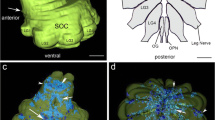Abstract
Stimulation of the tail nerve (pedal nerve 9, p9) of the mollusk, Aplysia californica, causes release of serotonin (5-HT), which mediates sensitization of withdrawal responses. There are about 35 serotonin-immunoreactive (5-HT-ir) axons in p9, yet the cell bodies of these axons have not been located. Backfills of p9 were combined with 5-HT immunohistochemistry to locate the cell bodies of 5-HT-ir neurons with axons in p9. About 100 neurons had axons in p9. Only about ten neurons, however, were both backfilled and 5-HT-ir. These double-labeled neurons were all located in the pedal ganglion associated with p9, which had a total of approximately 42 5-HT-ir somata. The discrepancy between the number of 5-HT-ir axons and double-labeled cell bodies is not likely due to neurons having multiple axons in the nerve; intracellular fills suggest that these neurons do not branch before entering p9. Additionally, no evidence was found for peripheral 5-HT-ir cell bodies that project axons centrally through p9. Thus, approximately 70% of the neurons that give rise to the 5-HT-ir axons in tail nerve are unaccounted for, but likely to reside in the pedal ganglion.




Similar content being viewed by others
References
Byrne JH, Baxter DA, Buonomano DV, Cleary LJ, Eskin A, Goldsmith JR, McClendon E, Nazif FA, Noel F, Scholz KP (1991) Neural and molecular bases of nonassociative and associative learning in Aplysia. Ann N Y Acad Sci 627:124–149
Fickbohm DJ, Lynn-Bullock CP, Spitzer N, Caldwell HK, Katz PS (2001) Localization and quantification of 5-hydroxytryptophan and serotonin in the central nervous systems of Tritonia and Aplysia. J Comp Neurol 437:91–105
Goldstein R, Kistler HB Jr, Steinbusch HW, Schwartz JH (1984) Distribution of serotonin-immunoreactivity in juvenile Aplysia. Neuroscience 11:535–547
Hawkins RD (1989) Localization of potential serotonergic facilitator neurons in Aplysia by glyoxylic acid histofluorescence combined with retrograde fluorescent labeling. J Neurosci 9:4214–4226
Jahan-Parwar B, S-Rózsa K, Salanki J, Evans ML, Carpenter DO (1987) In vivo labeling of serotonin-containing neurons by 5,7- dihydroxytryptamine in Aplysia. Brain Res 426:173–178
Katz PS, Eigg MH, Harris-Warrick RM (1989) Serotonergic/cholinergic muscle receptor cells in the crab stomatogastric nervous system. I. Identification and characterization of the gastropyloric receptor cells. J Neurophysiol 62:558–570
Kistler HB Jr, Hawkins RD, Koester J, Steinbusch HWM, Kandel ER, Schwartz JH (1985) Distribution of serotonin-immunoreactive cell bodies and processes in the abdominal ganglion of mature Aplysia. J Neurosci 5:72–80
Lebrand C, Cases O, Adelbrecht C, Doye A, Alvarez C, El Mestikawy S, Seif I, Gaspar P (1996) Transient uptake and storage of serotonin in developing thalamic neurons. Neuron 17:823–835
Longley RD, Longley AJ (1986) Serotonin immunoreactivity of neurons in the gastropod Aplysia californica. J Neurobiol 17:339–358
Mackey SL, Kandel ER, Hawkins RD (1989) Identified serotonergic neurons LCB1 and RCB1 in the cerebral ganglia of Aplysia produce presynaptic facilitation of siphon sensory neurons. J Neurosci 9:4227–4235
Marinesco S, Carew TJ (2002) Serotonin release evoked by tail nerve stimulation in the CNS of Aplysia: characterization and relationship to heterosynaptic plasticity. J Neurosci 22:2299–2312
Marinesco S, Kolkman KE, Carew TJ (2004) Serotonergic modulation in Aplysia: I. A distributed serotonergic network persistently activated by sensitizing stimuli. J Neurophysiol 92:2468–2486
McLean IW, Nakane PK (1974) Periodate-lysine-paraformaldehyde fixative. A new fixation for immunoelectron microscopy. J Histochem Cytochem 22:1077–1083
McPherson DR, Blankenship JE (1991) Retrograde labelling of serotonergic projections onto the neuroendocrine bag cells of Aplysia. Neurosci Lett 123:148–151
McPherson DR, Blankenship JE (1992) Neuronal modulation of foot and body-wall contractions in Aplysia californica. J Neurophysiol 67:23–28
Moroz LL, Sudlow LC, Jing J, Gillette R (1997) Serotonin-immunoreactivity in peripheral tissues of the opisthobranch molluscs Pleurobranchaea californica and Tritonia diomedea. J Comp Neurol 382:176–188
Ono JK, McCaman RE (1984) Immunocytochemical localization and direct assays of serotonin-containing neurons in Aplysia. Neuroscience 11:549–560
Philips GT, Sherff CM, Menges SA, Carew TJ (2011) The tail-elicited tail withdrawal reflex of Aplysia is mediated centrally at tail sensory-motor synapses and exhibits sensitization across multiple temporal domains. Learn Mem 18:272–282
Richards KS, Simon DJ, Pulver SR, Beltz BS, Marder E (2003) Serotonin in the developing stomatogastric system of the lobster, Homarus americanus. J Neurobiol 54:380–392
Vanhatalo S, Soinila S (1998) Serotonin is not synthesized, but specifically transported, in the neurons of the hypothalamic dorsomedial nucleus. Eur J Neurosci 10:1930–1935
Walters ET, Ambron RT (1995) Long-term alterations induced by injury and by 5-HT in Aplysia sensory neurons: convergent pathways and common signals. Trends Neurosci 18:137–142
Walters ET, Byrne JH, Carew TJ, Kandel ER (1983) Mechanoafferent neurons innervating tail of Aplysia. II. Modulation by sensitizing stimulation. J Neurophysiol 50:1543–1559
Walters ET, Bodnarova M, Billy AJ, Dulin MF, Diaz-Rios M, Miller MW, Moroz LL (2004) Somatotopic organization and functional properties of mechanosensory neurons expressing sensorin-A mRNA in Aplysia californica. J Comp Neurol 471:219–240
Weragoda RM, Walters ET (2007) Serotonin induces memory-like, rapamycin-sensitive hyperexcitability in sensory axons of Aplysia that contributes to injury responses. J Neurophysiol 98:1231–1239
Xin YP, Koester J, Jing J, Weiss KR, Kupfermann I (2001) Cerebral-abdominal interganglionic coordinating neurons in Aplysia. J Neurophysiol 85:174–186
Acknowledgments
We are grateful to Manfred Schmidt and Vivian Vu-Ngo for their help in teaching SJ vibratome sectioning. We thank Claudia Sanabria and Birgit Neuhaus for assistance with confocal microscopy. We thank Joshua Lillvis and Akira Sakurai for their comments on this manuscript and their help throughout this study. This project was funded in part by a grant from NSF.
Author information
Authors and Affiliations
Corresponding author
Rights and permissions
About this article
Cite this article
Jhala, S., Tamvacakis, A.N. & Katz, P.S. Toward locating the source of serotonergic axons in the tail nerve of Aplysia . Invert Neurosci 11, 91–96 (2011). https://doi.org/10.1007/s10158-011-0121-6
Received:
Accepted:
Published:
Issue Date:
DOI: https://doi.org/10.1007/s10158-011-0121-6




